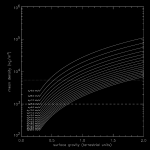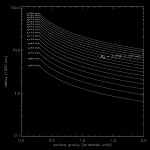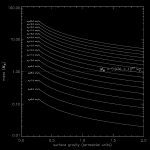In the STAR WARS universe we are introduced to many planets that have breathable atmospheres and surface gravity tolerable to humans. This habitability gives us some clues to assess the gross physical properties of the planets. I have generated some plots of planetary density (a rough hint at composition), planetary radius and mass, for given values of the surface gravity and the escape velocity. Dotted lines refer to Earth values; the dashed line on the first plot indicates the density of water.
The surface gravity of a world may be estimated by observing the rate at which free objects accerlate as they fall, the evolution and buoyant rise of fireballs and mushroom clouds from explosions, the distances over which people fall without harm, and the ability of heavier-than-air gliding objects to stay aloft.
The escape velocity is the minimum speed at which an object (or gas molecule) must be launched from the surface if it is to avoid falling back. The thermal motions of most gas particles in a planetary atmosphere must be slower than this escape velocity if the atmosphere is to be retained. Thus the escape velocity is a crude indicator of a world's ability to retain atmosphere. Considering the examples of habitable and nearly habitable worlds in our solar system:
Curves are plotted for escape velocities only up to 20 km/s, because that range is typical of a small gas giant like Uranus or Neptune. When such a world is forming, the atmosphere grows in a runaway manner, until the supply of interplanetary gas is removed from the young solar system.
The reference density of 1000 km / m³ is the density of water or ice (approximately). Silicates (rocky substances) are up to about three times as dense; the metals that comprise a planet's core are a few times denser still. For example, refer to periodic table data for the density of elemental iron.
These plots should provide a visual impression of the range of parameters that are realistic for a planet with tolerable gravity and the ability to retain an atmosphere in which humans can survive.
| mean density | radius | mass |
|---|---|---|

|

|

|
This page was constructed and is maintained by
Curtis Saxton.
This page is neither affiliated with nor endorsed by Lucasfilm Ltd.
Images included in or linked from this page are copyright Lucasfilm Ltd. and are used here under Fair Usage terms of copyright law.
This site is kindly hosted by TheForce.net.